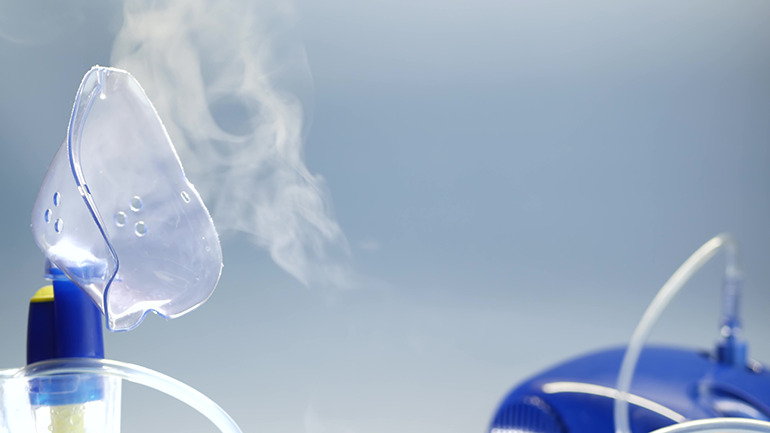
Oxygen equipment and gas in the home
The use of medical oxygen equipment can increase the risks of combustion in materials that would otherwise be inert. Gas Safe Register’s Technical Team set out what you need to know.
Many gas engineers might have customers who use medical apparatus at home, such as oxygen therapy and nebulisers, and you may not ever have given it a second thought. They’re perfectly safe when used as instructed, but mistakes do happen and you should be aware of potential issues and dangers.
Oxygen therapy in the home is a form of treatment for several serious health conditions, including respiratory and cardiac complaints. Oxygen is not flammable, unlike other gases and chemicals, but it is a high-energy gas that readily oxidises other materials and strongly
supports combustion. This means that the release of any additional oxygen into a fire or any other gas-burning appliance will greatly increase the intensity and rate of combustion. It could also aid in the combustion of materials that otherwise would be relatively inert.
An oxygen-producing device can pose a significant safety risk: for example, if the patient is using oxygen equipment near a naked flame such as a gas fire. An excess of oxygen in a room or space can be very dangerous, resulting in an increased level of risk in the combustibility of materials, including those considered to be non-flammable (such as metals) under normal conditions.
Oxygen is an oxidising agent, which means it gives oxygen to another substance, which strongly increases combustion. Levels of oxygen in the atmosphere above 21 per cent cause materials to burn more intensely, faster and hotter than in normal air. An increase of oxygen of around 3 per cent can double the combustion rate. And where medical equipment is involved, this means that a leaking valve or damaged oxygen hose in a poorly ventilated room can quickly increase the oxygen to a dangerous level.
The reactivity of oxygen increases when pressurised, and so oxygen equipment operating above atmospheric pressure at high flow rates can cause materials to burst into flames spontaneously. Substances that are not usually considered a fuel can cause a fire – oil, grease and even some metals can burn in the presence of an oxygen-enriched atmosphere. Therefore, the use of oil, grease or hand cream should be avoided when using oxygen equipment.
Non-inhaled oxygen that escapes from the patient’s mask can collect at a low level around them because oxygen is denser than air. For immobile patients, unused oxygen from the mask can flow on to their clothes and bedding, presenting a significant fire risk. An ignition source such as striking a match or using a naked flame can cause a serious flash fire, igniting clothing or bedding and potentially causing serious or fatal burns. Using oxygen equipment near an ignition source, such as a gas fire or back boiler, carries a similar risk.
There are no standards currently that give guidance on the minimum clearances required for oxygen-producing equipment from potential ignition sources. However, the NHS has the following guidance:
- Keep the room where the device is being used well ventilated
- Install fire alarms and smoke detectors and make sure they’re working
- Tell the local fire brigade that there is oxygen at home so that they can arrange a free fire safety check
- Keep devices at least 3 metres away from any open-flame appliances such as a gas cooker or gas fire
- Keep devices at least 1.5 metres away from other electrical appliances such as radiators or electrical heaters.
- DO NOT smoke or let anyone smoke nearby when the device is in use
- DO NOT use flammable liquids such as cleaning fluid, paint thinner or aerosols when using the device
- DO NOT use oil-based emollients when using the device as these can be a fire risk.
You should use your own engineering judgement coupled with what you encounter on site, and make sure that the room(s) where the oxygen equipment is used is ventilated adequately. If a person or oxygen-producing equipment and cylinders are in very close proximity to an ignition source – such as a gas fire or cooker – warn them of the danger and, where necessary, help them to move or reposition the equipment/cylinders. You may need to consider the patient’s needs and seek assistance from medical personnel if required.
Oxygen equipment
There are three main types of oxygen therapy:
- Oxygen concentrators
- Portable (ambulatory) oxygen
- Nebuliser therapy.
When people who have a respiratory condition use a nebuliser to relieve the symptoms, the gases given off by the device may affect the flame characteristics and hue. Depending on the concentration of these gases in the room, the burner flames can change colour, ranging from pale pink to bright orange.
The flames also appear to be larger than normal: this is because they are affected by salts in the gases that expose the full outer mantle of the flame that is usually not visible to the naked eye. The flames will return to their normal size and colour once the room has been purged with fresh air.
* This is a slightly abridged version of the Technical feature in the November/December 2023 issue of Registered Gas Engineer.